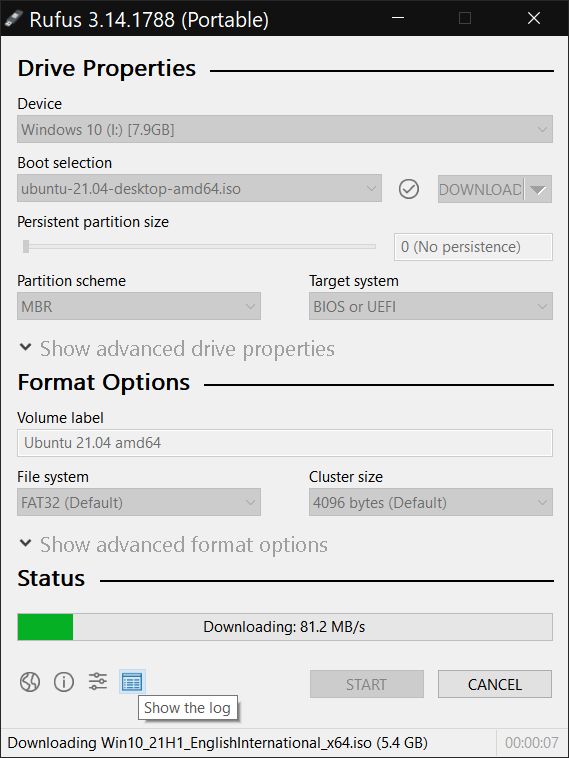

- #Writing a live usb rufus iso or dd how to#
- #Writing a live usb rufus iso or dd install#
- #Writing a live usb rufus iso or dd full#
- #Writing a live usb rufus iso or dd windows#
It can also boot windows iso files, img files and other things. Then when you boot the USB - it gives you a menu of which ISO you want to boot. With it - you run the ventoy tool - it converts the USB into a bootable 'ventoy usb' you copy as MANY ISO FILES as you want onto the ventoy data partition. (persistence) use of the USB as a data drive under windows and so forth.

These changes can cause issues with some Distros. ISO mode - uses a fat32 filesystem, and extracts the contents of the ISO and does some other things to make a bootable USB. It will basically be identical to a usb made with any other 'direct image' tool such as dd or BalenaEtcher. The usb will be a clone of the iso, it will not be fat32, it will not have any persistance or save file. Windows Method A: Unetbootin If you already have Unetbootin installed on your computer then skip to the next step (2). public IP addresses or hostnames, account numbers, email addresses) before posting!ĭoes this sidebar need an addition or correction? Tell me hereĭd mode - writes a straight image file. Note: ensure to redact or obfuscate all confidential or identifying information (eg. If you fix the problem yourself, please post your solution, so that others can also learn. ✻ Smokey says: use a light-weight OS on your computers, such as Linux, to fight climate change! If you're posting for help, please include the following details, so that we can help you more efficiently: Any distro, any platform! Explicitly noob-friendly. Be very careful about which output device you pick or you may overwrite something you did not intend to! On my machine I ran dd if= introductions, tips and tutorials. If using dd for Windows, run dd -list and look carefully at the list of NT Block Device Objects and use the one that looks like \\?\Device\Harddisk1\Partition0 where the description is something like Removable media other than floppy. If using a version of Windows newer than 7, make sure you unmount the USB drive first (formatting it prior to launching the disk copier is one way to accomplish that), otherwise Windows might refuse to write on the stick, bailing out with the "can't write to drive" error message. If you are experiencing problems installing CentOS from a USB stick and you used a utility other than dd on linux or the 4 listed above as 'working', then recreate it with one known to work before you try anything else.
#Writing a live usb rufus iso or dd install#
It will allow you to install the OS on a PC, or simply test it in Live mode.
#Writing a live usb rufus iso or dd how to#
Also Rufus does not work correctly if the wrong options are chosen so the tool is best avoided. This article explains how to create an Arch Linux bootable USB thumb drive. Moreover, the CentOS 7 installer image has a special partitioning which, as of July 2014, most Windows tools do NOT transfer correctly leading to undefined behaviour when booting from the USB key.Īpplications known (2019) that do NOT work are: unetbootin, multibootusb and universal usb installler - do NOT use these. Make sure you select as destination the device corresponding to the USB key ( /dev/sdz in the above example) and not a partition (such as /dev/sdz1)Įxactly the same method works for CentOS 7. This procedure allows a CentOS install without network connectivity and with no media other than a bootable USB device and the target system disk.ĬentOS release 6 (6.5 or newer) and CentOS 7 and 8 Many recent systems, particularly netbooks and small notebooks, may not have a CD or DVD drive and a network install may be difficult, impractical, or impossible, depending on network connectivity and installer support for the available network hardware. On linux, use the sha256sum command to do the same job. It will basically be identical to a usb made with any other direct image tool such as dd or BalenaEtcher. On Windows you can use the command certutil -hashfile c:\Users\JDoe\Downloads\CentOS-x86_64-dvd1.iso SHA256 to perform this checksum. The usb will be a clone of the iso, it will not be fat32, it will not have any persistance or save file. You should check that your downloaded copy has a sha256sum that matches the published one to eliminate corrupted media install problems. These can be found in the release notes for each new version and also in a text file located in the same directory that you obtained the iso image from.
#Writing a live usb rufus iso or dd full#
The CentOS Project publishes a full list of the sha256sums for each iso file.


 0 kommentar(er)
0 kommentar(er)
